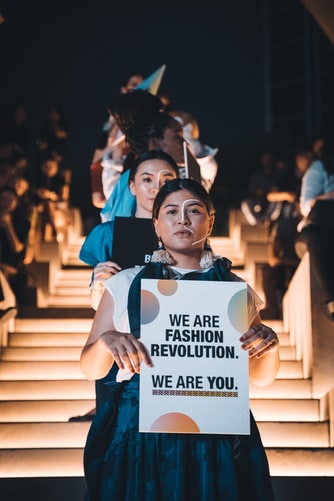Image by mohamed Hassan from Pixabay
“Fast fashion isn’t free. Someone, somewhere is paying.”
Sustainability is no more an alien concept as too many people have been voicing their authentic concern for it. Ironically not many know that the fashion industry comes immediately next to the Oil and Gas industry in the context of pollution. This fact regrettably has been overlooked so far due to the flawed choices of consumers. Buying clothes before the 1990s used to be a special event. New clothes were only bought during festivals or celebrations. However, this lifestyle concept began to change in the late 1990s when shopping started to become a means of entertainment and people started spending more of their disposable income on it. Today, there are millions of fashion brands worldwide vying for the attention of consumers like never before. The most prominent brand names encompass H&M, Zara, Uniqlo, Topshop, Mango, Forever 21, the list goes on.
What Is Fast Fashion?
Most of us are well acquainted with these global brands that are making their spectacular presence felt across the worldwide shopping malls. When you come across these brands what is the first thought that strikes your mind? Maybe “I love the clothes here”, “They are super trendy and affordable” or something along these lines. Surprisingly, these brands are reckoned as the top fast fashion business houses. According to Investopedia, fast fashion is labelled as cheap clothing produced on a mass scale. Fast fashion originated in a bid to quickly take forward designs from fashion shows to supplier stores to capitalize on trending fashion. This encouraged mainstream shoppers to succumb to these fashion trends and procure the latest available designs. Fast fashion democratizes style and offers an affordable avenue for people to buy clothes. Unfortunately, the entire democratization does come at expense of mass production, use of toxic substances, exploitation of factory workers and beyond. However, it is our planet that bears the brunt of fast fashion most in a multitude of unimaginable detrimental ways.

Photo by freestocks on Unsplash
What Exactly Is Wrong With The Fast Fashion Industry?
Fast fashion, over the years, has encouraged a throwaway mentality amongst modern consumers mainly. Despite being associated with exploitative labour practices and poor working standards, fast fashion retailers continue to rule through the roost of the mainstream fashion industry and with their revenues average crossing billions per year. Moreover, the media and brands have compelled us to believe that we require buying clothes regularly to keep up with the latest trends by leveraging the emotion of vulnerability or fear of being left out. This means that we end up buying more clothes than we require by ultimately discarding the old ones swiftly.
How Fast Fashion Is Destroying the Planet?
Research has shown that more than half of our closet ends up in a landfill somewhere, within 3-8 years of purchasing. In the past, clothes were made of raw materials empowered with natural fibres, such encompassing cotton, wool, silk, jute, linen and more. These fibres, despite requiring an enormous amount of water to be cultivated, were naturally obtained. However, today more than 60% of clothing is made out of synthetic fibres like polyester. The production of these synthetic fibres releases 3 times more carbon dioxide than natural fibres. Moreover, to produce these fibres, many chemicals are used along with massive amounts of oil. Following the current trend, by 2050 the fashion industry would be responsible for nearly 26% of carbon dioxide emissions, which would be even more than emissions of all the flights and ships combined.
Fast Fashion’s Environmental Impacts
Coming to the impact of synthetic fibres after production, they are usually not biodegradable. This translates to a huge amount of pollution in the oceans through microplastics. According to an article by Ngan Lee published in the Princeton Student Climate Initiative, the fast fashion sector is to be blamed for close to 35% of microplastics in the ocean today. Microplastics are small fibres that are detached from synthetic clothing when they are washed. While they most certainly have a significant impact on the marine life, it has started impacting humans as well, through the consumption of seafood. The fashion industry also pollutes water owing to the chemicals occurring in dyes and other toxic substances.
“There is no such thing as “away”.
When we throw anything away it must go somewhere”
What Fashion Conscious Personal Brands Are Doing About It?
There is no dearth of people who have been vocal about the fast fashion industry and its detrimental impacts. Jemma Finch, the co-founder of ‘Stories Behind Things’ and a fashion influencer, believes in sustainable and ethically sourced fashion. Her Instagram feed is proof that you can support sustainable fashion without ever having to compromise on style. Renowned actress Emma Watson is a UN ambassador is another woman who strongly advocates sustainable fashion. She has a separate Instagram account where she posts about the sustainable high fashion clothes she wears during tours. She also further supports the brands by crediting them and encouraging her followers to support such brands. No wonder, more and more high fashion brands are also trying to implement sustainable fashion in their collections. A few global ethical brands like Stella McCartney (London-based) and Aachho (Jaipur: India-based) have incorporated the fashion sustainability concept into their clothes and have also taken a commendable step to ensure deploying natural fabrics.

Photo by Francois Le Nguyen on Unsplash
How Can We Make A Difference?
Buying less clothing may not be a feasible solution owing to a dynamic contemporary lifestyle. To address the major environmental concerns related to fast fashion, buying sustainable and ethical clothing seems like the perfect feasible solution. Ethical and sustainable brands like Aachho makes it possible by offering a range of versatile fashion that can be worn on a multitude of occasions.
While investing in attires, it is most essential to consider the fact that an outfit or a piece of clothing has been designed or manufactured by leveraging natural fibres and dyes instead of synthetic ones. Responsible fashion houses like Aachho have been able to initiate a positive change in the industry. If we take a glance at the global fashion brands then there are brands like ‘Purposeful Retail’, ‘Factory 45’ and ’Novel Supply Co.’ that require constant support to translate their vision of transforming the fashion industry into a sustainable industry.
Another powerful way to make a difference is to wash your synthetic clothes less. This will reduce the number of microplastics being fed into the ocean. Signing petitions and offering support to environmentally conscious fashion brands and business houses that take extra safety measures can make a huge difference. These brands install filter systems in their textile factories to prevent chemicals from entering water streams, even if their prices are slightly higher than other brands.
By making small changes, we can prevent several issues such as the exploitation of labour along with minimizing the negative impact we have already triggered on nature. We should change our mindset and focus on finding a sustainable approach to fashion because as consumers, the biggest responsibility lies with us.
“Sustainable Fashion is not a trend but the future”
From The Editor-in-Chief
The clothes that we embrace play a pivotal role in the environment. The future of forthcoming generations is in our hands hence it is our key responsibility to take a step forward towards sustainable fashion.
“Call it eco-fashion if you like, I think it is just common sense”
Top Evils Of Fast Fashion Industry
Fast Fashion costs cheap in terms of money but when it comes to the well-being of the planet and human life, it proves to be extremely expensive. The top evils of Fast Fashion industry are:-
I. Soils Degradation
II. Water Pollution
III. Rain Forest Degradation
IV. Child Labour
V. Inhumane Working Conditions
VI. Land Pollution
VII. Toxic Clothing Substance
VIII. Forced Labour
IX. Green House Gas Emissions and beyond.
Role Of Fashion Conscious Brands In Minimizing Fast Fashion
The complete absence of the fast fashion business may seem like a distant dream. However, myriad sustainable brands like Aachho do acknowledge the significance of the prominent 5 elements of Nature that act as the energy source in the context of natural fibre production. Conscious fashion is at the helm of sustainable fashion brands like Aachho who leverage the goodness of eco-friendly tie and dye inks by ensuring the overall well-being of their artisan community. These conscious fashion brands are striving to make a positive impact on the environment and planet by doing things the ideal way. Can’t we consumers make an informed choice by extending support to them? Can we stop treating clothes like disposables? Can we embrace buying superior-quality ethical fashion built to last? It is time to recognize your unique fashion voice by defining your fashion morals.
“Ethical should be the new normal”
As a consumer, if we lack the concern to grasp from where the outfit is coming from, what was the inspiration of the fashion brand and from what is the story behind it, what is the use of following fashion trends blindly? An outfit no matter ordinary or branded deserves to convey inspiring epiphanies.
Let’s make the right choice today to work towards a better future tomorrow by seeking inspiration from the Aachho Tribe who value ethical fashion over anything.
“Ethical fashion is the recognition that there are human beings
behind the clothes that we wear”.
This Blog Post is brought to you by Aachho. If you are mindful than ever when it comes to fashion clothing choices, explore Aachho’s sustainable fashion collection oozing an inimitable nostalgic vibe. Every single attire is simply perfect for your unique style and is beneficial for the artisan community as well as for the planet. Aachho is amongst those rare global fashion-conscious brands that inspire you to pursue your distinctive fashion style irrespective as you break free from the downbeat trend of fashion slavery.
Will you be part of the sustainable fashion solution by embracing sustainable fashion that imparts an opportunity to elevate the needleworkers and artisan community?
Will you be a part of the sustainable fashion solution to save our beautiful planet?
If yes then share in the comments, how!


